|
 Swat the Shopping Bug to view related military items!
Swat the Shopping Bug to view related military items!
 |
THE HISTORY OF THE FIGHTING KNIFE
Knives have been a key fighting weapon in every war. No matter how advanced the technology, a good knife always has a place in battle. Military knives make an ever growing segment of the collector's market.
A special breed of knives saw extensive development during WWII. Known as the "fighting knife". While it could be employed for the uses of a regular knife, its primary goal was for hand-to-hand combat. The design, balance and materials employed varied from the run of the mill knife.
This page provides a sample of the various fighting knives used during WWI and beyond. The samples displayed here cover various countries that participated in the war. Information provided includes the identification of fighting knives and pricing of fighting knives.
|
THE US M3 FIGHTING KNIFE
The M3 Fighting Knife or M3 Trench Knife was an American military combat knife first issued in 1943. It was issued to soldiers who carried weapons that did not have bayonets. The early models were issued with a leather scabbard which
had a bottom metal plate for re-enforcement. Later models were issued with a fiberglass scabbard which was later
used in many other models.
The design of the M3 was used for the M4 Bayonet for the M1 carbine.
|
| 1 |
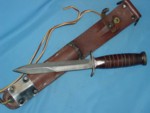 |
Developed in 1943, the M3 figthing knife was manufactured in large quantities. The design consisted of a leather handle with multiple grooves applied at intervals. This featured allowed for better grip of the knife. The pommel is a metal, flat disc with a starburst pattern metal spike that attaches the pommel to the handle. The blade was double edge, stilleto type.
|
View
Photos |
M3
History |
| 2 |
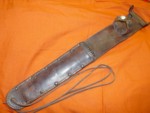 |
This is an example of an M3 fighting knife leather scabbard. A section of leather extends out from the main body
and has a loop which secures a wire hook in place. This is how the knife was attached to the
utility belt
or backpack.
Heavy white cotton stiching and multiple rivets are employed to secure the sides of the scabbard.
The front of this example has information stamped on it.
|
View
Photos |
M3
History |
| 3 |
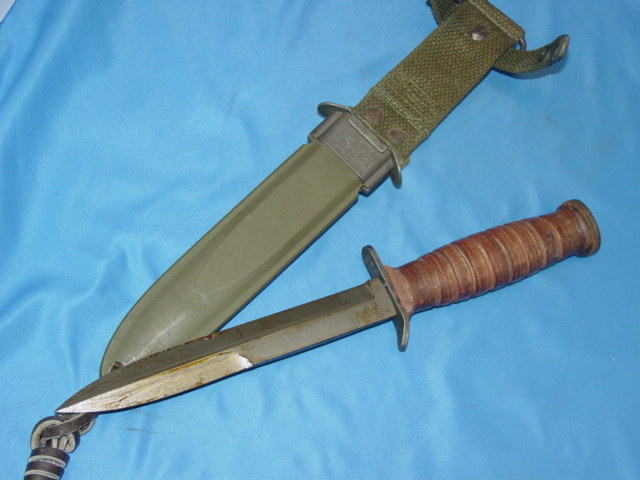 |
This is a US M-3 fighting knife. As issued to members of the US army during WWII. In very good condition.
The pommel consists of a round metal piece. The handle is made of leather and has multiple indentations.
The scabbadr is made of leather and retains the leather leg tie.
|
View
Photos |
M3
History |
| 4 |
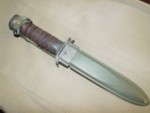 |
This is a US Army M-3 fighting knife. Manufactured by the CASE company during WWII. The manufaturer's marking
can be found on the crossguard. The handle is made of leather. Multiple ridges are cut in place to provide
better gripping. The scabbard on this exaple is made of fiberglass.
|
View
Photos |
M3
History |
| 5 |
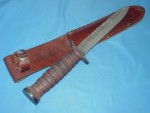 |
The Camillus comnpany manufactured this M3 fighting knife. The pommel is made of metal and has a rectangular wedge on
top. The handle is made of leather. One side of the crossguard is pointing down while the other side is straight.
The blade is single edge through the first half then turns double edge towards the tip. The markings are found on the
blade. The scabbard is made of brown leather and also has the Camillus stamp on it.
|
View
Photos |
M3
History |
| 6 |
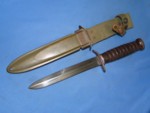 |
This is an M-3 fighting knife. As issued during WWII. It was manufactured by the Case company. In very good condition.
The pommel consists of a metal disc. The handle is made of leather and has a series of ridges. The markings are found
on the crossguard. The scabbard is made of green fiberglass. The throat has a metal piece with the markings US M8A1.
|
View
Photos |
M3
History |
| 7 |
 |
This is a very interesting M3 fighting knife. It was manufactured by the Imperial company. The pommel is standard.
The handle is different. It has a black/dark brown bakelite piece at each end, followed by leather construction. The
blade is marked US M3 IMPERIAL along the side. The scabbard is made of leather. It is also marked imperial and has a
date of 1943. The owner wrote his name in what appears to be faded black ink. The pommel has the flaming bomb stamp.
|
View
Photos |
M3
History |
| 8 |
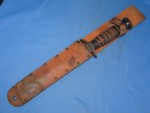 |
This is an unmarked M3 knife. As issued to US Army personnel during World War Two. The pommel is of regular construction.
The handle has a black bakelite section at each end, sandwhiching the standard leather rings. The blade is nice and
bright. The scabbard is the leather version.
|
View
Photos |
M3
History |
THEATER MADE FIGHTING KNIVES
The term "Theater made knives" refers to a class of knives that were used by United States armed forces but
were not produced in the United States as part of standard issue equipment. Many of these knives were manufactured
during WWII in places like Australia, China and other theaters of operation. Several of these edge weapons were
created from parts from downed aircraft.
The term was also applied to knives manufactured by US personnel while being deployed. Many of these weapons
were created in navy ships where the sailors had access to the machines, time and materials to build the knife.
These items were sometimes decorated with colored stones or lucite handles.
There were a large number of theater made knives produced. Due to their spontaneous nature and the lack of
manufacturing controls it is next to impossible to determine how many were made, the number of styles or to
catalog them all.
|
| 1 |
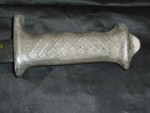 |
The item featured on this page is an Australian made fighting knife. Used by the US Marine Corps in WWII. Single piece aluminum construction. This was not standard issue by the government. This was a private purchase.
The knife was issued with a brown leather scabbard. Rivets and heavy duty white cotton stitching were placed along the edges of the scabard to secure it shut. It cam with a belt slit and a snap to secure the knife in place.
Several variations of the fighting knife existed.
|
View
Photos |
View
History |
| 2 |
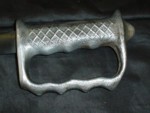 |
The item featured on this page is an Australian made knife. Employed by USMC personnel during WWII. The knife was not official issued equipment. This is a private purchased knife.
Of single piece of aluminum construction. The handle has a checkered pattern. Half loop handguard. The knife was provided With a brown leather scabbard. Three rivets and heavy duty white cotton stitching are placed on the edge of the scabbard to provide strength. A downward strap with a bronze button secures the knife into place. An angled belt slit is also provided.
|
View
Photos |
View
History |
| 3 |
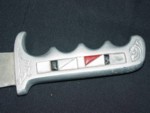 |
This is an example of a theater made fighting knife. Single piece construction. All aluminum (possibly aircraft material). The blade shows good quality. The handle is very ornate. one side has multiple swirl designs while the other is covered with stones, one appears to have fallen off. The scabbard, if one ever existed, was likely made of leather. More than likely built during WWII in one of the theaters of operation.
|
View
Photos |
View
History |
| 4 |
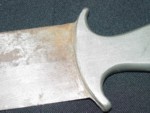 |
This is a theate made USN knife. More than likely this knife was made by a Sailor who had acces to the machine shop in the ship. They would have alot of idle time in between battles or while traveling from location to location.
Single piece construction. Battleship gray leather scabbard and metal. double edge blade. This is a fine example of a WWII theater made knife.
|
View
Photos |
View
History |
| 5 |
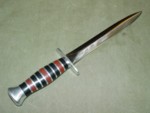 |
The design of the knife is very slick. Stiletto type blade. The handle is composed of a series of multi-colored rings. the pommel is integrated with the rest of the body. It is of silver color. The knife measures around 11 inches in length. It is fairly well balanced.
Most of the theater made knives did not have any markings. This one is not an exception as no markings are found anywhere.
The scabbard, if one ever existed, would have been manufactured of leather.
|
View
Photos |
View
History |
| 6 |
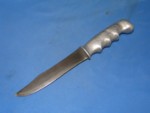 |
This is a theater made knife. All aluminum construction. The handle has a series of peaks and valleys designed to
better fit the fingers of the user. No scabbard. In very good condition.
|
View
Photos |
View
History |
| 7 |
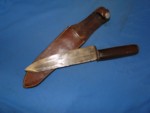 |
This is another example of a theater made knife. The handle is made of wood. very nicely designed. Single edge blade
with no markings. Complete with a brown leather scabbard which has a snap in the upper section which ensures the knife is
secured when placed in the scabbard.
|
View
Photos |
View
History |
| 8 |
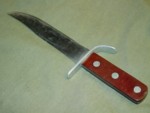 |
This is an interestingly designed theater made knife. From the WWII period. The handle is made of dark brown plastic and
is secured via the use of three aluminum rivets. The crossguard has one component that is straight while the other goes
in the upward direction. The blade is of single edge.
|
View
Photos |
View
History |
| 9 |
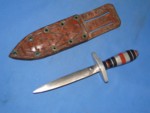 |
This is a WWII theater made knife. All alluminum construction. The handle is composed of a series of colored discs.
The crossguard is all straight. Double edge construction blade. The scabbard is made of brown leather and has a
series of decorations. The sides are riveted in place.
|
View
Photos |
View
History |
| 10 |
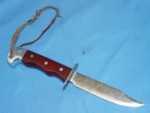 |
This is a WWII period knife. As used by the US military in the theater of operations. The handle is brown in
color and it is formed to the hand. Three rivets hold it in place. The crossguard is small. The blade is of
single edge. A leather string passes through the pommel.
|
View
Photos |
View
History |
| 11 |
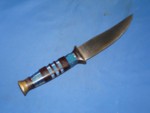 |
The handle of this knife has a seried of colored discs. The pommel is in the shape of a crown. In very good condition.
All aluminum construction. The crossguard is small. The blade is of single edge construction. manufactured during
WWII.
|
View
Photos |
View
History |
| 12 |
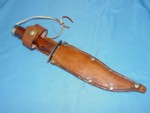 |
This is another example of a WWII theater made knife. The handle is round and made of wood. The pommel consists of
a round metal cap. The blade is of single edge construction. No markings at all. the scabbard is made of brown
leather.
|
View
Photos |
View
History |
| 13 |
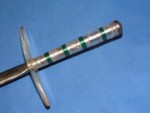 |
While not a fighting knife, this WWII letter opener was constructed using the same techniques and materials as
the WWII fighting knives. The handle is made of several sections of Lucite. The colors alternate from clear
to dark green. Very nice quality.
|
View
Photos |
View
History |
| 14 |
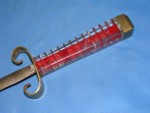 |
This is another example of a WWII letter opener that was built using the same style as the fighting knives. The Lucite
sections in the handle are square and clear. the center is red. the pommel and crossguard are of metal construction.
nice quality work.
|
View
Photos |
View
History |
| 15 |
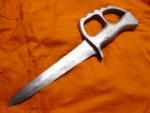 |
This is a theater made USMC knuckle buster fighting knife. all aircraft alumium construction. purchased from the
son of the veteran. The story goes that his father made it using the equipment from the machine shop of the ship
that was transporting him to the South Pacific battlefields. The design is similar to the ones used in WWI.
|
View
Photos |
View
History |
THE US NAVY FIGHTING KNIVES
The main function of any naval force is to protect the waterways of their country or to project power onto other lands
or oceans. The modern Navies use ocean going ships to perform this task. Most of the Personnel in these ships do not
need fighting knives. However, there is a contingent of individuals who have to land and fight just like the Army
and marines do. It is priomarily for this group that the Navy created fighting knives.
|
| 1 |
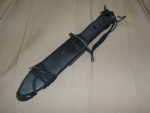 |
This is a US Navy SEALS fighting knife. MK 3 Mod 0. As issued during the 1990's and 2000's. High tech construction.
Checkered high impact plastic grips. The blade is serrated and has the model number stamped at its base.
Complete with the scabbard.
|
View
Photos |
View
History |
| 2 |
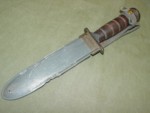 |
This is a US navy Mark 2 knife. As issued during WWII. in very good condition. COmplete with the fiberglass
scabbard. The pommel consists of a metal disc. The handle is made of leather.
|
View
Photos |
View
History |
| 3 |
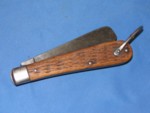 |
This is a WWII Coast Guard folding knife. Wooden handle construction. A lanyard metal loop is found on one end. The
base of the blade is marked USCG. In very good codition.
|
View
Photos |
View
History |
| 4 |
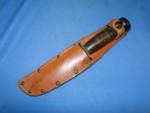 |
This is a US Navy knife. Manufactured by the Camillus company. The pommel is made of bakelite. The blade is single
edge with the name of the company stamped on one side and the letters USN on the other. The scabbard is made of
brown leather.
|
View
Photos |
M3
History |
THE WWI FIGHTING KNIVES
WWI was a brutal war that was largely fought in the trenches. Each side dug up large arrays of trenches facing the
enemy. Groups of soldiers would mount attacks in an attempt to get into the enemie's trenches and pushed them
back. When a soldier was able to breach the defenses and enter somebody else's trench the fighting that ensued
took place in very close quarters. Hence the need to develop a specialized fighting knife such as the knuckle
buster. a soldier could slash, stab and punch with the same edge weapon. Additional knives were also developed
for multiple purposes.
|
| 1 |
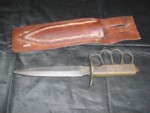 |
This is perhaps one of the most recognizable trench knives of WWI. Manufactured by the LF&C company. The handle
is made of brass and has a built-in knuckle duster design. The pommel is a pointed nut designed for striking. The
blade if of double edge construction.
|
View
Photos |
View
History |
| 2 |
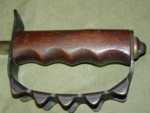 |
This is a WWI US Model 1917 trench knife. Of wooden handle construction. The handguard is composed of a series of souble
teath design to cause damage when a strike is delivered. The blade is of triangular shape. This design causes wounds
that are harder to heal. Manufactured by the A.C.C.O. company and dated 1917.
|
View
Photos |
View
History |
| 3 |
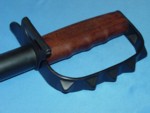 |
The trench knife featured here is another M1917 model. The main difference is the design of the handguard. This one
consists of pyramid shape knobs. These provided a striking surface that could cause significant damage to an
opponent in battle. Manufactured by the LF & C Company. dated 1917. The scabbard is a combibation of leather and
metal. The design was not very effective as it was easy to separate the metal and leather junctions. The blade
was also of triangular shape.
|
View
Photos |
View
History |
| 4 |
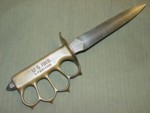 |
This fighting knife of WWI is perhaps the most recognizable edge weapon of the war. Many copies of this style
are presently being made for sale at shopping malls, swap meets and other venues. Manufactured by the LF & C
company. Dated 1918. Brass and steel construction. The pommel has a heavy duty pointed surface for striking
down. The handle is made in the shape of knuckle busters designed for delivering strikes.
|
View
Photos |
View
History |
| 5 |
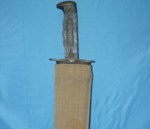 |
This is a WWI US Army bolo knife. The grips are missing. They would have been made of wood. The blade is very broad
towards the tip. Very heavy duty construction blade. The base is marked with the date of 1917. The scabbard is made
of medal and has a khaki canvis cover.
|
View
Photos |
View
History |
THE BOLO KNIVES
This verion of the Bolo knife was introduced by the United States during WWI. Its used extended into WWII.
A classical trademark of this knife is its robust blade. The knife was issued to Army personnel. During
WWII they were issued to the US Marines. The letters USMC would be stamped in the blade along with the
date of manufacture.
|
| 1 |
|
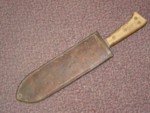 |
This is a WWII US Marine Corps Bolo knife. Dated 1943. One of its most interesting characteristics is the heavy duty
construction of the blade. Wooden handle held together by four rivets. The scabbard is made of leather.
|
View
Photos |
View
History |
| 2 |
|
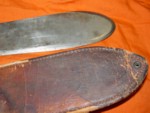 |
This is a US marine corps bolo knife manufactured by the Bridell company, As used during WWII in the South Pacific
theater. The handle is of wooden construction. The blade is veryu thick and heavy. The side is marked with
U.S.M.C and Bridell just bellow it. The knife measures around 18 inches in length.
|
View
Photos |
View
History |
| 3 |
|
 |
This is a WWII USMC bolo knife. Manufactured by the Village Blacksmith company who was well known for producing
this type of knife. Complete with the heavy duty leather scabbard, which is also stamped with the USMC letters.
Dated 1943.
|
View
Photos |
View
History |
| 4 |
|
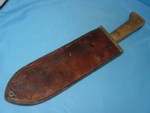 |
This is another example of a WWII bolo knife. In very good condition. Wooden handle construction. The scabbard
is of dark brown leather. Very heavy duty construction.
|
View
Photos |
View
History |
| 5 |
|
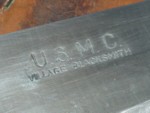 |
This is a United States Marine Corps bolo knife. in overall good codition. Manufactured by Blacksmith Village
which was well known for producing bolo knives during WWI and WWII.
|
View
Photos |
View
History |
| 6 |
|
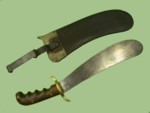 |
This is an eraly version of the US Army bolo knife. Issued during the early 1900's, pre-WWI. With a heavy duty
leather scabbard. The metal throat is much larger than that used in future designs. It also has a hinged bracket
which acts as a hanger. The blade is large and is marked on both sides. The pommel and crossguards are of brass
construction.
|
View
Photos |
View
History |
| 7 |
|
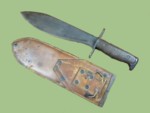 |
This is a US Army bolo knife. As issued during World War one (WWI). Wooden handle with some ridges all throughout. Two
rivets are used to hold it in place. The blade is of single edge construction and heavier towards the tip. The
scabbard is of heavy duty construction. Leather held together with large metal rivets.
|
View
Photos |
View
History |
| 8 |
|
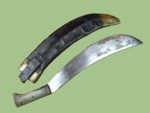 |
The US Army Corps of Engineers had a very interesting looking bolo knife. The design was similar to a machete except
that the blade was much ehavier and had more of a curvature. The handle is made of a bone-like material held
together by two rivets. The scabbard is of leather construction with brass tip and throat. A separate leather
strap is attached to the back to form a belt loop.
|
View
Photos |
View
History |
THE MILITARY SURVIVAL KNIVES
The military forces from all nations are always concerned about training their forces the necessary skills to
survive in the wild by themselves. The posssibility of a pilot being shot down in the jungle or the desert
during combat operations is very real. Therefore the military has developed survival equipement that the pilots
can use. Including a Survival knife. Other possibilities include a navy ship sinking, an infantry soldier
getting separated from the group, etc. All these eventualities can be better survived with the hepl of a
good knife.
|
| 1 |
 |
The folding machete was a part of the US Army Air Force pilot survival kit that was issued for the South Pacific.
The design consisted of a heavy duty, single edge blade with a had plastic handle. A hinging mechanism would allow the blade to fold into the handle. some of the blades were manufacturer marked. The one featured on this page does not have any markings.
|
View
Photos |
View
History |
| 2 |
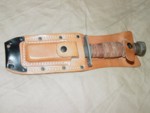 |
This is a 1980 US Air Force Pilot survival knife. This knife had to be small due to space restrictions in the
cockpit. The handle is made of leather as it is the sheath. The pommel is multi-sided and could be used to
hammer things down. The blade has a serrated side. A small pocket for the sharpening stone is found in the
front of the scabbard.
|
View
Photos |
View
History |
| 3 |
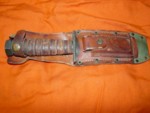 |
This is another example of the US Air Force pilot survival knife. Manufactured by the Camillus company of
New York. Dated 1984. The handle is made of leather. The blade has one serrated side,
|
View
Photos |
View
History |
| 4 |
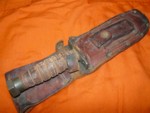 |
This US Air Force knife was manufactured by the Ontario company in 1986. The knife was issued to pilots in case
they were shut down. The scabbard is made of leather and has a front pocket where the sharpening stone is housed.
The back of the scabbard is stamped with the unit number.
|
View
Photos |
View
History |
| 5 |
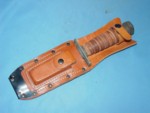 |
This is a fine example of a Camillus made survival knife. Dated 1980. Manufactured in New York. This example shows
very little wear.
|
View
Photos |
View
History |
| 6 |
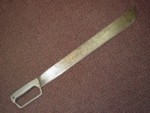 |
This is a WWII US Army machete. very interesting design. It is made of aluminum. Unlike other designs produced
for use of the United States armed forces. The handguard is integrated to the handle. The blade shows manufacturer
markings. This machete is very hard to find.
|
View
Photos |
View
History |
| 7 |
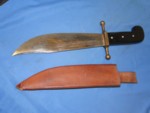 |
This is a US army Air Force V-44 Pilot Survival Knife. This edge weapon was issued as part of a survival
equipment kit. in very good condition. The handle is held together via the use of three rivets. The
crossguard is made of brass. The blade is of single edge construction. The scabbard is made of brown
leather. This example was manufactured by the Kinfolks company.
|
View
Photos |
View
History |
THE FAIRBAIRN SYKES FIGHTING KNIVES
The Fairbairn-Sykes Fighting Knife is a double-edged knife with a foil grip developed by William Ewart Fairbairn and Eric Anthony Sykes in Shanghai before World War II, but made famous during the War when issued to British Commandos, including the SAS. The F-S Fighting knife often is compared to a stiletto; the comparison is misleading, as the stiletto is for stabbing and has a longer, narrower (often triangular) blade that typically features no sharpened edge at all.
The Wilkinson Sword Company made the knife with minor pommel and grip design variations; currently, the F-S Fighting Knife is of interest mainly to collectors. Because of its sleek lines and its commando association, the OSS, the Marine Raiders, et al., it remains in production to date. The knife is so symbolic of British commandos that a solid gold F-S Fighting Knife is part of the commandos' memorial at Westminster Abbey. The knife features in the insignia of the British Royal Marines, Dutch Commando Corps, founded in the UK during WWII, the Australian 2nd Commando Regiment, and the United States Army Rangers.
|
| 1 |
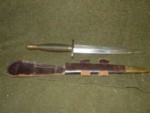 |
This is a Fairbairn Sykes British knife. As issued to commando forces during WWII. The handle is round and thin.
The pommel is of smooth construction. The crossguard is very small. The blade is of stiletto style. The knife
was well known for its qualities for knife fighting. The scabbrd is made of leather. It has four leather tabs
protruding from the side of the main body.
|
View
Photos |
View
History |
| 2 |
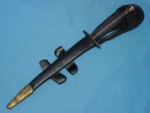 |
This is a British special forces Fairbairn sykes fighting knife. As issued after the war. The design remained
virtually the same with a circular pattern handle. Small crossguards and double edge blade. The scabbard is made
of black leather with a brass tip.
|
View
Photos |
View
History |
| 3 |
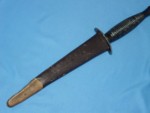 |
This is another example of the fairbairn Syles military knife. As issued after WWII. Complete with a brown leather
scabbard and brass tip. Used by British and American special forces.
|
View
Photos |
View
History |
| THE M4 FIGHTING KNIFE / BAYONET |
| 1 |
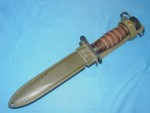 |
This is an M-4 fighting knife / bayonet. As issued to US soldiers during WWII. With a leather handle designed in a
ring pattern. A metal crossguard. The scabbard is made of fibergalss and painted green. A canvis tab is attached
to the top section to allow soldiers to carry the edge weapon on the utility belt.
|
View
Photos |
View
History |
| 2 |
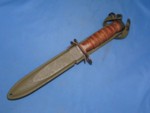 |
The M-4 bayonet was issued to be used with the M-1 carbine rifle. The design of the bayonet allowed it to be used as a
fighting knife. The pommel has the locking mechanism for attaching to the rifle. Of leather handle. the scabbard
consisted of a fiberglass body with a canvis strap at the top capped with a wire hook. This is a well known
military knife.
|
View
Photos |
View
History |
| 3 |
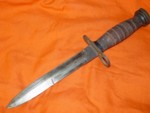 |
This is an interesting bayonet. It is a copy of the US M4 however, this model was made in Japan after WWII.
The US government assisted Japan's economic recovery in part by giving Japanese companies contracts to
produce items for the US. Used with the M-1 carbine rifle.
|
View
Photos |
View
History |
THE KABAR FIGHTING KNIVES
KA-BAR was a fighting and utility knife issued to American armed forces including the Marines and Navy. KA-BAR is also the name of a related manufacturing company most known for the same 11 3/4-inch fighting and utility Bowie knife adopted by the United States Marine Corps and United States Navy as the USN Fighting Knife Mark II.
The name "KA-BAR" came to be after the company received a poorly written English letter in which the author wrote how the company's knife saved his life after he was attacked by a bear and his gun failed to kill it. All that was legible was "k a bar"�presumably fragments of the phrase "kill a bear"�and the company adopted that as their trademark. In 1942, soon after the United States' entry into World War II, American troops found that trench knives such as the M1917/1918 or Mark I were only suited to trench warfare and not to WWII combat.
New designs were sought from hunting gear catalogs. The U.S. Marines bought many different knives and designs from a large number of knife suppliers. After extensive trials under field conditions, the KA-BAR fighting knife was found to be the most popular among troops because it was adequate for most tasks demanded by a combat soldier. The Marine Corps made several changes to the original design, these included the introduction of a small fuller to make a slightly longer but lighter blade for combat, a pinned pommel and a stacked leather handle for better grip. The blade, guard, and pommel were all finished in a non-reflective matte phosphate finish instead of the brightly polished steel of the original design.
|
| 1 |
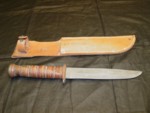 |
The Kabar knife issued to the US Marine Corps during WWII has attained a legendary spot in the annals of history.
Its durability and out right usability earned its reputation in the battlefields of the South Pacific. The handle
is made of leather rings compressed together. the blade is of sinle edge.
|
View
Photos |
View
History |
| 2 |
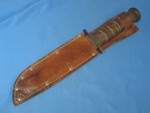 |
This is a US Kabar knife. As issued during WWII. Leather handle. Single edge blade. The scabbard is made of
leather with rivets enforcing the sides. A strap forming a loop is found in the top side of teh scabbard. This
is how the knife was attached to a utility belt. This is a well known military knife.
|
View
Photos |
View
History |
| 3 |
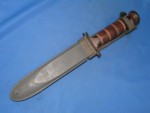 |
This is another example of a Kabar fighting knife. WWII period. The handle is made of compressed leather discs.
The pommel is round and thick. This particular knife comes with a fiberglass scabbard. A canvis strap is attached
to its top. This is how the knife was secured to the utility belt. The scabbard has a hole in the tip to
allow a string to go through so the knife could be secured to the leg of the soldier.
|
View
Photos |
View
History |
| 4 |
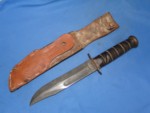 |
With a leather handle. Multiple crevices between the rings. The pommel is made of a circular piece of metal.
The crossguards are small. Single edge blade. The scabbard is made of leather.
|
View
Photos |
View
History |
| 5 |
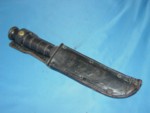 |
This is a US made fighting knife. As used during WWII. Manufactured by the Camillus company of New York. The handle
is made of leather discs. The name of the company is stamped at the base of the blade. The scabbard is made of
leather and has rivets re-enforcing its perimeter.
|
View
Photos |
View
History |
| 6 |
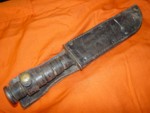 |
This is a US made Camillus fighting knife. As used during WWII. The handle is made of leather discs that are
compressed together. A separation is found between each disc. The pommel is round and thick. The scabbard is
made of brown leather with rivets re-enforcing the sides.
|
View
Photos |
View
History |
THE SPECIAL FORCES FIGHTING KNIVES
Special forces are versatile and agile military assets capable of providing discreet reconnaissance, surveillance and capacity building to other states' security forces. They are suited to operating against informally structured, irregular and asymmetric forces and capable of operating independently, or in direct support of either conventional military forces or other government departmental requirements. They are high value assets, commanded at the strategic level that deliver effects disproportionately to their size.
These are the knives that were designed for and issued to the special forces. Groups like the paratroopers,
OSS, SAS, etc. The fighting knives shown here cover a period between WWII and the present.
|
| 1 |
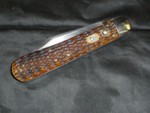 |
One of the new pieces of equipment that was developed was the paratrooper switch blade. The idea behind the knife was to provide the paratrooper a way out in the event that he had an injured or trapped arm and his parachute was hung on a tree. The knife needed to be readily accessible and have the ability to be opened with one hand. The item featured here is
a US paratrooper switchblade.
|
View
Photos |
View
History |
| 2 |
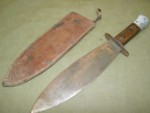 |
The item featured here is an OSS Smatchet. This was a fairly large fighting knife used during WWII by US and
British forces. The pommel is made of aluminum. The grips are wooden with two rivets holding them in place.
The blade is of double edge construction. The scabbard is made of leather and has a single strap with a snap
to retain the knife in place.
|
View
Photos |
View
History |
| 3 |
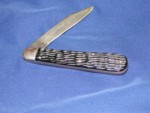 |
This is another example of the WWII US army paratrooper switchblade. With black plastic handles that have an
indented pattern. No lanyard loop found at the butt section. safety switch and release button.
|
View
Photos |
View
History |
| 4 |
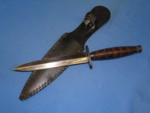 |
This is an example of a fighting knife. The country of origin and time period is unknown. Very high
quality construction. Double edge blade. Leather handle. Metal pommel in a sleek shape. the
scabbard is made of black leather.
|
View
Photos |
View
History |
| 5 |
 |
This is an example of a V-42 fighting knife.
The V-42 was designed in part by the Commanding Officer of the brigade, Lt. Colonel Robert T. Frederick. Every part of the knife was made with the intent of combat. This knife was the trademark weapon of the Devil's Brigade, and its members were trained extensively in the use of this knife. The profile of this knife is pictured on the crests of the Canadian Special Operation Forces Command, Canadian Forces's Joint Task Force 2 and the one of the United States Army Special Forces.
|
View
Photos |
View
History |
THE ARMY FIGHTING KNIVES AND BAYONETS
|
| 1 |
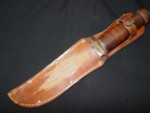 |
This is US WWII knife manufactured by the Queen company. The handle is made of a series of compressed leather rings.
The pommel is also made of leather. The crossguards are very small. The scabbard is made of brown leather.
|
View
Photos |
View
History |
| 2 |
 |
This is US WWII era fighting knife. Manufactured by the Cattaraugus company. Type 225Q. The pommel is composed of a
thick, round disc. The very top shows two large rivets and the rectangular shape of the end of the tang. The handle
is made of leather. The crossguard extends to one side only. The scabbard shown here is a replacement and not the one
that came witht he knife.
|
View
Photos |
View
History |
| 3 |
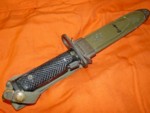 |
This is a US Army bayonet for the M-14 rifle. As issued during the Vietnam war. The grips are made of black, hard
plastic. Two rivets hold them in place. The crossguard has one end with a circular hole as to allow the barrel
of the rifle to pass through.
|
View
Photos |
View
History |
| 4 |
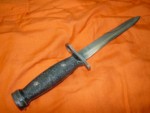 |
This is a US army M4 bayonet. As used with the M-16 rifle during the Vietnam war. Manufactured by the Bren-Dan
company.
|
View
Photos |
View
History |
| 5 |
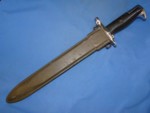 |
This is a US Army M-1 garand bayonet. Long design (approximately 22"). Complete with the fiberglass scabbard. the
pommel is made of metal and has the shape of a beak. The grips are made of plastic. The scabbard has a wire hook
system that allows the person to attach the bayonet to a utility belt or the side of a backpack.
|
View
Photos |
View
History |
| 6 |
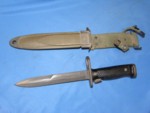 |
This is a US Army M-14 bayonet. As issued during the Vietnam war. Hard black plastic grips with a checkered pattern.
Fiberglass scabbard. Release activation button is found at the base of the grips, next to the crossguard.
|
View
Photos |
View
History |
THE RH KNIFE SERIES
The Remington company owns the PAL knife company. In the early 1900's the PAL company launched a series of knives
titled RH, which means Remington Hunting. The RH series developed civilian as well as military knives.
In the early days the knives were primarily produced for hunters. As World War Two got on its way the company
produced a series of fighting knives bearing the same nomenclature. This section of the website covers knives for combat
and hunting purposes.
|
| 1 |
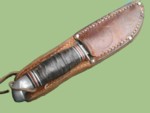 |
This is an RH 4 knife. With an aluminum pommel, dovehead shape. The handle is made of a series of leather rings.
The blade is of single edge construction and has a blood groove that extends for most of the body. The blade is
marked with "Remington, Dupont, RH 04" at the base. The handle is made of brown leather.
|
View
Photos |
View
History |
| 2 |
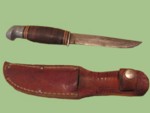 |
RH 24:
This is an RH 24 knife. Manufactured by the PAL company. In very good condition. Complete with the leather
scabbard. The pommel is made of aluminum. The handle is composed of a series of leather rings. Most of them are
dark brown with the exception of the ends, which are colored.
|
View
Photos |
View
History |
| 3 |
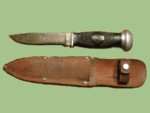 |
This is an RH 28 knife. TConstructed of a solid black rubber handle with a pattern on both sides. Some of the handle
is checkered for better grip. The words "Remington, UMC" are displayed on one side. The pommel is made of
aluminum. The crossguard is virtually non-existant. The blade is of single edge design. The word "Remington" is
found at the base. The scabbard is of brown leather construction.
|
View
Photos |
View
History |
| 4 |
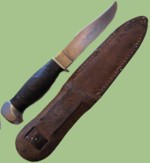 |
This is an RH 29 knife. This is a Black rubber handle knife with a checkered pattern applied to certain areas.
The words "Remington UMC" are found in the center of the handle. The blade is of single edge construction. The
base is marked with "RH29 5 1/4". Part of the backm of the blade is serrated. The scabbard is made of brown
leather.
|
View
Photos |
View
History |
| 5 |
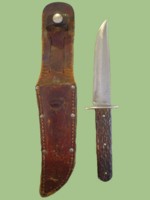 |
This is an RH 30 knife. The handle is made of bone-like material with three small silver rivets holding it in place.
The blade is of single edge construction. The base has the markings "RH30 5 3/4". The scabbard is made of brown
leather and has a circular logo stamped on it.
|
View
Photos |
View
History |
| 6 |
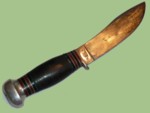 |
This is an RH 32 knife. Aluminum pommel followed by a series of leather circles which form the handle. The blade is of
interesting construction. Single edge with an upward curvature. The base has the markings "RH32" with a circular logo
between the RH and 32. The scabbard is of brown leather construction.
|
View
Photos |
View
History |
| 7 |
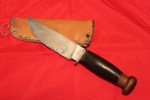 |
RH 34:
This is an RH 34 PAL knife. In very good condition. An interesting aspect about this knife is that it has a wooden
pommel. The blade is of single edge construction. The scabbard is of after market production. It is not the
scabbard that was manufactured by the factory.
|
View
Photos |
View
History |
| 8 |
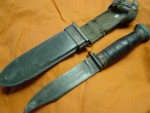 |
RH 35:
This is the RH 35 model fighting knife. Manufactured by the PAL company. Issued during WWII. the pommel is made
of aluminum. the handle is composed of a series of leather discs some of which are different colors, specially
near the ends. The scabbard is made of fiberglass but actually belongs to a USN MK1 knife.
|
View
Photos |
View
History |
| 9 |
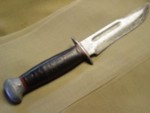 |
RH 36:
This is a WWII fighting knife manuifactured by the PAL company. It is the type RH 36. It is one of a series of knives
that was produced by this company. The pommel is made of aluminum. The handle is composed of a series of leather
rings. The blade is of single edge. A blood groove is present.
|
View
Photos |
View
History |
| 10 |
 |
This is an RH 45 knife. The handle is of wooden construction with a large checkered pattern all throughuot. Two large
aluminum rivets hold the handle in place. A lanyard hole is located near the pommel. The blade is of single edge
construction with an upwards curvature. The scabbard is of leahter construction and has a belt loop opening.
|
View
Photos |
View
History |
| 11 |
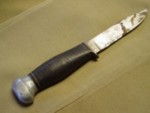 |
RH 50:
This is a US Navy RH 50 knife. Manufactured by the PAL company. The pommel is made of aluminum. The handle is composed
of a series of leather discs where the end discs are black while the rest are brown. Single edge blade with markings
applied to the base.
|
View
Photos |
View
History |
| 12 |
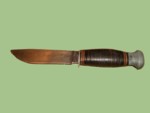 |
RH 51:
This is an RH 51 knife. Manufactured by the PAL company. In very good condition. The pommel is made of aluminum. The
handle consists of a series of leather rings pressed together. The blade is of single edge.
|
View
Photos |
View
History |
| 13 |
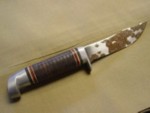 |
RH 56:
This is a knife manufactured by the Western company. Type 56. The pommel is made of aluminum. It has a section that
protrudes out. The blade is of single edge construction. It has a series of rust spots. The handle is made of a
series of leather discs. The center portion being brown while the rest are colored.
|
View
Photos |
View
History |
| 14 |
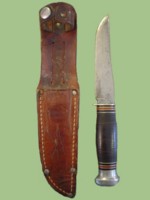 |
This is an RH 70 knife. With an aluminum pommel followed by a series of leather rings. No crossguard is
present. Single edge blade. The scabbard is made of brown leather. The remnants of a circular logo that
was stamped in the front is visible. The base of the blade is clearly marked "RH 70".
|
View
Photos |
View
History |
| 15 |
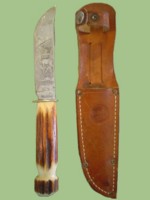 |
This is an RH 73 knife. The handle is made of stag with a crown pommel. The crossguard is very small. The blade is
of single edge construction and is adorned with a hunting scene. the base is marked on both sides. One reads
"Remington" while the other reads "RH 73". The scabbard is made of leather. This is a civilian knife.
|
View
Photos |
View
History |
| 16 |
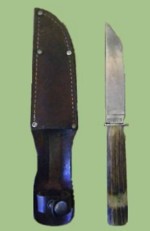 |
This is an RH 75 knife. Stag handle construction. Straight type with a lighter ring near the end. Single edge
construction with the marking "RH 75" found at the base. The knife is made in the USA. the scabbard is of black
leather construction with a series of rivets and stiching enforcing the sides.
|
View
Photos |
View
History |
| 17 |
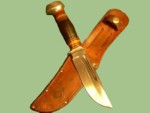 |
This is an RH 134 knife. With a large aluminum pommel followed by a series of leather rings. The crossguard is
single sided. The blade is of single edge design with a blood groove covering close to 50% of the blade length.
The markings RH134 5" is found at the base. Leather scabbard.
|
View
Photos |
View
History |
| 18 |
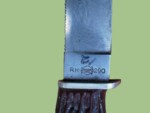 |
This is an RH 290 knife. With a round aluminum pommel. simulated stag handle construction. Single sided crossguard.
The blade is single edge with a serrated back. The base is marked RH 290. The scabbard is made of brown leather.
|
View
Photos |
View
History |
|







